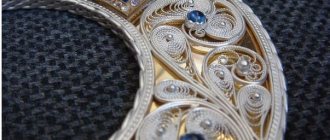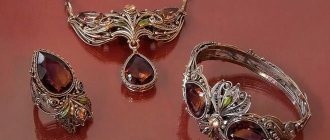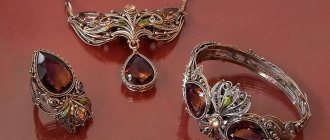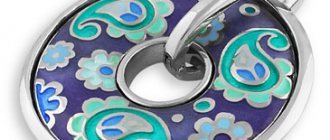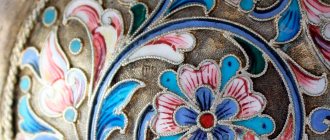The ancient secrets of jewelry masters are being revived and becoming incredibly popular in the modern world. But there are special techniques that have not undergone changes for millennia, such a technique includes cloisonne enamel; craftsmen create unique household items, exclusive jewelry and give part of the secret to the mass market. Therefore, today everyone can afford jewelry with cloisonné enamel.
What is cloisonne enamel
The essence of this technique is as follows: a thin wire is used to create a pattern on a plate (usually silver or gold). The wire acts as a divider. The more accurately the line is drawn with wire, the cleaner the effect will be.
The gaps in the pattern (windows) created by the wire are filled with liquid, fusible glass. Then the workpiece undergoes “finishing” in a muffle furnace.
The heating process is repeated many times until the coating becomes sufficiently hard.
Algorithm for manufacturing methods
The algorithm for creating products using the cloisonne enamel technique is as follows:
- First, a sketch of the product is developed, and then, using white gouache and tracing paper, this sketch is transferred to copper. The resulting drawing is fixed using a scriber;
- Next, they begin cutting out the workpiece using a hand jigsaw. Using a special hammer, the workpiece is given the required volume, and the contour is aligned with a needle file so that it matches the sketch as accurately as possible;
- The resulting object is annealed and bleached in acid, then covered with transparent paint and placed in a kiln at a temperature of 800 degrees;
- At the next stage, partitions are made. To make them, they take special rolled silver wire (the silver must be of the highest standard). Using pliers and tweezers, the wire is given the desired shape, bending fragments of the pattern, after which it is glued to the surface of the workpiece. The glue used to fix the wire is designed specifically for such purposes, so it gradually burns out during further firing of the product;
- As a result, cells are formed, which are soon filled with enamel diluted with water. Then, before firing, the workpiece must be thoroughly dried, otherwise the water will boil and splatter the enamel;
- The dried workpiece is placed on a special stand and sent to a muffle furnace at a temperature of 800 degrees. The product should be in the oven for only one minute, after which it is removed and allowed to cool at natural ambient temperature. It is important to avoid sudden temperature changes that can damage the enamel. To achieve the desired color, it is necessary to fill and re-fire enamel of different shades.
The product is ready, now all that remains is to make a base for it from a suitable metal, secure it and then it can be used.
Hot cloisonné technique
Hot enamel is burned many times. As the silica powder softens, it settles, although initially it filled the cells of the composition to the brim. The craftsmen take out the products, let them cool, sprinkle them with powder and return them to the oven.
As a result, the layer of cloisonne fabric and the layer of glass should be the same. If there are deviations after baking, the decorations are polished. It’s easy to imagine processing miniature pendants and bracelets.
However, historical cloisonne enamels from China are mostly large in shape. They were commissioned by the imperial court, in particular by Queen Jingtai, who ascended the throne in 1450. Can you imagine how painstakingly and for a long time it took to polish the cloisonné enamel on meter-long vases?
The cloisonné technique cannot, in principle, be mechanized. Grinding, pulling out the matrix, soldering and pouring powder are done manually. And in the 21st century, this is done by hand by craftsmen, as it was in the Jintai period.
The art of enamel in the 19th century
In the 19th century, craftsmen from the largest Russian jewelry companies used all the techniques of enamel art and even revived long-forgotten ones. In 1842, the famous jewelry factory of Gustav Faberge opened in St. Petersburg. The enamel business was also carried out by the companies of Ovchinnikov, Sazikov, Khlebnikov, Kurlyukov, the Grachev brothers, and the workshops of Tenisheva and Rückert. Mass production made enamel products very popular and widespread.
Art historians called the end of the 19th and beginning of the 20th century the “golden age” of Russian enamel.
They mainly made items for decorative and gift purposes: various types of dishes, cutlery and cutlery, jewelry (brooches, hairpins, earrings, etc.), boxes, handles for canes, and other household items. Often, jewelry with enamel was made to order and presented as unique, original gifts for holidays and significant dates. Emperor Nicholas II greatly valued silver and enamels; he had many such items in his collection.
In addition, Russian craftsmen invented window enamel. The companies of Pavel Ovchinnikov and Ivan Khlebnikov were especially successful in this. A glassy mass with a high water content was filled into an openwork rock ornament - and, having hardened, it looked in the light, like a stained glass window. They fired it many times, since during cooling it often resulted in failures. This required special skill and caution. But this technique was not widely used: fragile products could not serve practical purposes.
Dish with the coat of arms of St. Petersburg. Firm of Carl Faberge. Master Perkhin M.E. 1896 Ladle. The company of Carl Faberge. Master Ruckert F.I. 1899-1908 Easter egg Clover. Carl Faberge firm. Master Perkhin M.E. 1902 Easter egg-clock with a bouquet of lilies. Firm of Carl Faberge. Master Perkhin M.E. 1899 Desk clock. Master Wigström Heinrich. 1908-1917
Studying at the Academy of Arts
At the end of the 19th century, a special enamel painting class was created at the Academy of Arts, where enamellers received professional education. Moreover, their work was valued and paid higher than that of painters. Unfortunately, the names of the masters are almost unknown: they rarely signed their works. Sometimes the name was left on the counter-enamel, but on the medallions mounted in the products, the inscription cannot be read.
Along with the portrait, the enamel miniatures represent all the genres that existed in painting at that time. Even a historical painting, although the seemingly intimate form of this art is not conducive to the embodiment of large themes. The collection of the Armory Chamber of the Moscow Kremlin contains a snuff box, on the lid of which the family of the Persian king Darius is depicted in front of Alexander the Great. When creating a complex multi-figure composition, the artist clearly focused on the painting. Moreover, he was able to skillfully copy it, because, judging by the handwriting, he studied at the Academy of Arts.
Chinese cloisonne enamel Jintai
The enamel, named after her, is distinguished by rich shades of azure and gold. The blue shades were obtained by grinding minerals, especially azurite. The tradition, again, remains unchanged. By mixing colorless stone powders with colorless quartz, jewelers achieve natural, rich, unique colors.
Transparent quartz enamel is the basis of the Georgian cloisonne technique, Chinese, Japanese and others.
The thickness of cloisonne enamel rarely exceeds a millimeter. Typically, the thickness of the contours of the drawings is a fraction of a millimeter. Thin threads of metal resemble a spider's web. The drawing is weightless, but strong and beautiful. By the way, solders for partitions must be fireproof. Otherwise, the pattern will come apart at the seams in the oven.
18th century enamel miniatures
The creativity of the masters of this century, in particular those from Solvychegodsk, prepared the way for the appearance of enamel miniatures in the 18th century. Among her genres, portraits predominated, and not by chance. The Petrine era affirmed the importance of the human personality. At this time, a national school of portrait painting began to form.
Miniatures were made on copper, silver and gold. The metal plate was covered with a layer of plain, usually white enamel and fired several times until it became even and smooth. The applied painting was covered with fondon - a transparent glassy mass that protects the painting from scratches. And the reverse side of the plate was necessarily filled with counter-enamel, otherwise cracks could form on the surface due to uneven cooling of the metal and enamel. When painting, the enamel artist used the dotted technique: he applied paint with dotted touches of the brush. This made it possible to convey the finest color nuances and light and shade.
Enamel artist G.S. Musikiysky
The creator of Russian portrait miniatures in enamel is Grigory Semyonovich Musikiysky. It is known that in 1710 he was listed as a painter at the Armory Chamber, and a few years later he was named in documents as a “master of enamel.” Many of his works have survived. Among them, portraits of Peter I, his wife Catherine I, their children, and Prince Menshikov predominate. Enamellers never painted from life, but repeated well-known paintings. The State Hermitage Museum houses a portrait of Peter I by Musikiski, based on an original by the famous artist Jan Kupetsky. Peter is depicted as a statesman-transformer against the backdrop of the new northern capital he founded and the Russian fleet. Beautiful color scheme: pure azure and crimson-red tones in combination with dark armor and white ermine mentia create a rich color scheme.
Musikiysky G. S. Portrait of Peter I. 1720
Application
In the 18th century, enamel miniatures were inserted into rings, medallions, bracelets, placed on snuff boxes, and used to decorate religious objects. And if in the middle of the century enamel was bright and rich, then later it was replaced by two-color, made in white-gray or white-blue tones - the so-called grisaille.
Jewelers also invented new decorative techniques. The craftsmen of Veliky Ustyug covered the surface of copper dishes, goblets, and cups with plain enamel and fused silver relief overlays into it, which were cast in special matrices. These could be bouquets of flowers, all kinds of coats of arms, ladies and gentlemen in magnificent costumes, mythological scenes and landscapes, and even entire cities and fortresses. On a white, blue, dark blue, turquoise background, the images looked elegant.
Cup. Veliky Ustyug. end of 17th century
Guilloche
In the last quarter of the 18th century, guilloché enamel was widespread. An ornament in the form of rays, stars, concentric circles, zigzags was applied to the surface of the metal, and the top was covered with transparent enamel. And it sparkled so much that it could compete with the brilliance of precious stones. Jewelers used this technique to create elegant snuff boxes, which then became fashionable and became an integral part of the costume.
Snuff box with replaceable decor. Guilloche enamel.1760s
Cold cloisonné technique
Glass is not always durable. Filling with hot glaze gives a commendable hardness of 7-8 on the Mohs scale. But there is also a cold pouring technique. Liquid polymers are used.
In reality they are plastics. They immediately fill the cells. The material itself is susceptible to damage, and there is no multi-layering. As a result, cold enamel is easily scratched and susceptible to household chemicals. The degree of baking of the products is also inadequate. It only takes 450 degrees Celsius to harden the enamel.
Cold enamel is often used to update classic jewelry to extend its life a little. Hot repairs cost the same as a new product and are performed by just a few technicians.
LiveInternetLiveInternet
Quote from aramill_stells post
Read in full In your quotation book or community!
Chinese cloisonné and painted enamels - Jingtailan
Champlevé and cloisonné enamels. The most famous techniques of artistic enamels on metal in China were champlevé (tsang-tai fa-lan 鏨胎琺琅), cloisonné (jing-tai lan 景泰藍) and painted enamels (hua fa-lan 畫琺琅). Champlevé enamels are not widely used.
They involve the use of hammered or engraved metal (as a base) and a colored glassy mass - enamel (fused into prepared recesses or recesses on the metal surface) for decorative finishing. The resulting artistic effect often resembles stone or glass inlay.
Perhaps this is why some researchers (for example, Liu Liang-yu) tend to find analogies of such products among very archaic things. Already individual bronze ritual vessels and parts of weapons of antiquity (2nd - 1st millennium BC) are inlaid with colored stones and glass. Those works in which the inserts are fixed by firing can be considered prototypes of later champlevé enamels.
In Japanese collections, only a few items of this kind have been preserved that could have been made in the Tang era (618-907). Some published works from the first half of the 15th century, owned by the famous private collector Pierre Oldry, combine cloisonné and champlevé enamel in their decoration. Most of the known objects from museums and private collections in China and beyond were created, however, during the reign of the Manchu Qing dynasty (1644-1911). Currently, there is reason to believe that before the Manchu conquest, any serious production of champlevé enamels in China had not yet been established: according to specialists from the Beijing Gugong Museum, its beginning probably dates back to the reign of the second Qing emperor under the motto Kang-xi (1662 -1722). The Chinese name for the champlevé enamel technique is zang-tai fa-lan, which literally translates to “enamel on a chased (carved) base.” In scientific literature in European languages, champlevé enamels, regardless of their cultural affiliation, are usually designated by the French name - champlevé.
From the moment of its appearance to the present day, cloisonné enamels have been the most popular in China. In the literature, their other common name is also accepted - cloisonné (from the French cloison, “partition”). The term reflects the essence of the production process - in the manufacture of such things, multi-colored powder enamels were fused during firing in the cells of a pattern formed by lines of metal wire partitions. Objects made of metal with enamel, first brought to China as a result of foreign trade with medieval Byzantium and the countries of the Middle East, called dashi yao 大食窯 (“Arab fired ware”) at the beginning of the Ming period, stimulated the development of similar production in China. A popular Chinese term for the cloisonné technique is Jing-tai lan, which literally translates to “turquoise blue [of the] Jing-tai [period], referring to the short reign of the Ming Emperor Dai-tsung 代宗 under the motto Jing-tai 景泰 (1450-1456) , which became the time of the first flowering of cloisonne enamels in China. The term that reflected the technological characteristics of the phenomenon - 掐/搯絲 琺琅 qia/tao si fa-lan, “bent (twisted) wires [and] enamels” appears mainly in specialized Chinese literature. The main centers for the production of cloisonne enamels were the northern capital - Beijing, the most important southern port - Canton (Guangzhou) and Yangzhou, located on the Grand Canal in the area of the river. The Yangtze, which in the past served as an intermediary in trade between the north and south of China. In the 19th century, especially during the years of Guang-xu (1875-1908) in Beijing, in addition to the palace workshops, the products of which were often marked with imperial stamps with the mottos of the boards, there were also private workshops.
Already in ancient times, having mastered the art of bronze casting and the secret of melting colored glass, the Chinese possessed the technical skills and materials that later formed the basis for the production of cloisonne enamel. The Beijing palace enamel workshops may have been founded by the Mongols during the Yuan period (1271-1368), when craftsmen and technologists from countries where the craft flourished were brought in to produce items for the court. The catalog of enamels of the Beijing Gugong Museum presents eight items that, according to the authors, belong to the Yuan period, and more than half of the published enamels are marked with stamps of the Jing-tai reign. Apparently, the question of the existence of a well-functioning production of enamels in Mongolian times still cannot be considered completely resolved.
The art of cloisonne enamels in China reached remarkable perfection during the reign of the Manchu Qing dynasty (1644-1911). This is understandable: jing-tai lan, with their bright, not to say variegated, polychrome decoration, being a phenomenon introduced into Chinese culture relatively late, in many ways did not correspond to traditional aesthetic standards.
Cao Zhao 曹昭, a Chinese writer of the 14th century, left a written remark in the treatise “Ge gu yao lun” 格古要論 (“Discourse on Antiquity/Ancient Patterns,” first published in 1387) that cloisonne enamels are not suitable for a scientist’s office with its cold and restrained interior, but are suitable only for women’s quarters (where they were actually widely used). But the Manchu aristocracy loved enamels, so during the Qing period such things became part of the items for the scholar’s desk; altar enamel sets, as a rule, decorated the interiors of Qing temples; The imperial residences, not only the pavilions of the palace on the women's side, but also the chambers of the rulers, abounded in enamel items. The emperor who reigned under the motto Kang-xi (1662-1722) paid a lot of attention to the development of this production and the collection of enamels, by whose will Chinese artisans successfully mastered new techniques for enamel production, for example, the technique of painted enamels. The grandson of Kang-xi, who ruled under the motto Qian-long (1736-1795), also paid special attention to enamel production.
The metal used by Chinese craftsmen to produce enamel molds is mainly copper and copper-based alloys. Chemical analysis by experts at Taiwan's National Palace Museum has shown that cloisonné enamels from the Ming period (1368-1644) often consist of an alloy containing 70-80% copper, 20-30% zinc and less than 1% tin and lead. In Qing times, along with pure copper, a similar alloy was used; The combined use of materials (pure copper and its alloys) was also allowed. From the second half of the 17th century. Iron, along with traditional materials, is beginning to be used for the production of partitions. During the reign of the emperors under the mottos of Yong-cheng (1723-1735) and Qian-long, pure gold was sometimes also used to make the base for enamel. In other cases, at the end of the production process, areas of metal free from enamel were usually gold-plated. The method of gilding practiced by masters of the Ming period - dujin 鍍金 (so-called “gilding by fire” using mercury amalgam) has been known in China since ancient times.
This decorative coating, which has now practically disappeared on many Ming enamels, is well preserved on things of the Qing period not only because they were produced much later, but also because of the better quality of gilding and the greater thickness of the gold layer in them. From the second half of the 19th century. production processes are mechanized and electroplating is used. Silver, as a rule, did not play a special decorative role in classical Chinese cloisonne enamels, however, among the works dating back to the end of the Qing period and the first third of the 20th century, one can distinguish a whole group of things with a silver and silver-plated base. During the same period, decorative patination of metal apparently became widespread.
Along with gilding, silvering and patination of fragments of metal forms free from designs, already from the Ming era the method of covering them with single-color enamel (the so-called “counter-enamel”) was used. According to its chemical composition, enamels are salts of silicic acid (lead silicate glass). Opacity is achieved by introducing arsenic oxide, tin, kaolin and other “silencers” into the alloy. Coloring is done by adding oxides of certain metals: copper, for example, gives turquoise, green and red tones; ocher and antimony – yellow; manganese - violet and purple; iron forms a red-brown color; Cobalt allows you to obtain blue colors of varying intensities. According to experts from the Taiwan Palace Museum, in rare cases, crushed minerals such as agate were used to obtain red color in enamels of the Jing-tai period. The first stage of work involved melting pieces of colored enamel at a temperature of 1300-1400 degrees Celsius. After this, the enamel was crushed into powder and ground with water to form a slurry (“slip”). Before placing the prepared mass into the cells of the design, the metal surface was treated with a gravel or etched with acid for better adhesion of the enamel to the metal. The objects themselves were fired several times, in a matter of minutes or even seconds, and at a low temperature (750-680 degrees Celsius), sufficient for the enamel powder to melt and adhere to the metal base. The first flowering of the art of cloisonné enamels was observed in China during the reign of the fifth emperor of the Ming dynasty under the motto Xuan-te (1425-1436), although according to the estimates of traditional culture, the best Ming enamels were created during the years of Jing-tai (1450-1456), becoming a common noun to designate all Chinese cloisonnés in general. Minsk enamellers achieved especially noticeable success in the first half of the 16th century. and at the beginning of the reign of Emperor Shenzong 神宗 under the motto Wan-li (1573-1620), who became famous as a philanthropist and zealous patron of Buddhism (fo-jiao). The preferences and tastes of the rulers and their close associates determined the artistic and figurative specificity of Chinese cloisonné enamels. In the cloisonne of the Ming period, those types of products of a domestic and sacred nature and artistic motifs of their design were found that later became traditional for this type of applied art.
Cloisonne enamels were used to decorate dishes and furniture, household and temple utensils. Along with the everyday and decorative forms of their time, in Ming enamels there is a group of sacred objects of very archaic forms, dating back to the ancient ritual bronzes of the Shang and Zhou eras (2nd-1st millennium BC). The idea of directly copying them was soon abandoned, moving to a more creative stylization, since it was necessary to adapt ancient forms to changing living conditions and find new uses for them. This is how the well-known types of temple vases and incense burners arose, common among Chinese enamels from the 15th century. One of the most popular is the “archaeological” form of the ritual tripod ding 鼎, although in its revived form the object has changed its purpose.
An ancient cauldron for preparing ritual food, the high legs of which made it possible to build a fire directly under the body of the vessel, became an incense burner used for burning incense and aromatizing the air in residential and temple premises. Other characteristic forms that have received a new birth are the ritual wine vessels hu 壺, zun 尊 and gu 觚. The biconic-shaped cup-gu, which in ancient times served for ceremonial libations of sacrificial wine, was preserved as a vase and over time became an integral part of the altar set of wu-gun 五供. The earliest cloisonne enamels of the 15th century. are massive forms cast from a copper-based alloy. Such things, as a rule, are colored with enamels of primary colors - turquoise, blue, green, yellow, red and white, which are applied to the metal body of the thing in a very thick layer (more than 1 mm). Their coloring is similar to the range of paintings of the Ming Shih Tzu 獅子, Feng Huang phoenixes 鳳凰, dragon moons 龍, the iconography of which also helps in determining the time of production of things.
For example, in the composition of shuang long si zhu 雙龍戯珠 - “a pair of dragons playing with a pearl” on enamels of the Wan-li period, the dragons are characterized by very specific features that make it possible to identify images of this time: bulging round eyes, eyebrows in the shape of a cock’s comb, a wide open mouth , long beard, flowing mustache, “raised” mane outlined in parallel lines. The character shou 壽, “longevity”, or swastika-wan 卍 is often placed between the dragon figures. The latter also served as a symbol of long life and was a particularly popular decorative motif during the reign of Wan-li, since it was a homonym of the first hieroglyph of this motto. Under Wan-li, both conventional geometric backgrounds and close-to-reality motifs of the hua-nyao genre were common in the decoration of cloisonné enamels - easily recognizable images of flying butterflies, flourishing shoots of plums, lotuses, chrysanthemums, carnations, camellias and other flowers that grew among garden flowers. stones yuan-lin-shi 園林石. Sometimes these motifs are juxtaposed with traditional conventional images of fantastic Shih Tzu lions and plant shoots in the form of a vine with the heads of stylized lotuses.
In addition to images of the Hua-Niao genre in cloisonné enamels from the turn of the 16th - 17th centuries. landscapes and everyday scenes spread in the landscape environment. Landscape compositions of this time combine images of rocky mountains, waterfalls, pine trees, architectural structures, people, as well as deer and cranes - images popular in connection with the idea of longevity, developed in Taoism. Characteristic signs of the time are a very high horizon line and a conventional color scheme. The onset of troubled times after the death of Wan-li (1620), preceding the change of dynasties, was marked by the absence of imperial control over craft workshops, which was resumed only in the 1690s, during the reign under the motto Kang-si - the second sovereign of the victorious Manchu Qing dynasty (1644 -1911). It is interesting that, compared to porcelain, the improvement in the quality of cloisonne enamels created under imperial control during this period is observed only ten years later. The most artistically interesting enamels of the Qing period were created during the three great reigns of the 18th century. (Kang-si, Yong-cheng, Qian-long) and after a long break in the last quarter of the 19th - early 20th centuries. In the decor of things of the 18th century. Matte enamels predominated, with the exception of transparent green enamel, used for some time in the cloisonné of the Kang-xi period.
Already at the beginning of the 18th century. Against the backdrop of the predominance of small household items, the revived court workshops sometimes produced large-sized cloisonnés, with some products marked with imperial stamps. Cloisonne enamels from the reign of Yong-cheng (1723-1735), as a rule, were not marked, and were often decorated with polychrome ornamental or floral patterns on a turquoise background, images of butterflies and flowers. The things of this reign are generally characterized by sparseness and elegance of compositions, in which the logic of geometric patterns inherited from earlier products is softened by the ease of natural forms. During the reign of Qianlong (1736-1795), which can rightly be called the “golden age” of Chinese cloisonnés, the palace workshops were reorganized and expanded. The desire of this sovereign and his close circle for splendor as a conscious lifestyle was manifested in the creation of luxurious and somewhat pompous works. Qianlong’s jealous interest in everything that was produced by the palace workshops was reflected in the abundance of cloisonné enamels of the 18th century. marked things.
In an effort to revive the traditions of the “hoary antiquity”, dating back to the “Zhou Li” (“Zhou Ritual”), Qianlong approved by law some archaic types presented in the collection of ritual utensils of the reigning dynasty (“Huang-chao faces of carcasses” 皇朝禮器圖式) bronze vessels for imperial sacrifices in the capital's churches, which became models for cloisonne enamels.
Catalogs of the palace collection of ancient bronzes compiled by imperial decree (the most representative of them was “Qinding Xiqing gujian” 欽定西清古監 highlighted character “jian” with the key “金” (“Highly approved [catalogue] of antiquities [of the cabinet] of Xiqing”), also gave a new impetus to the fascination with archaic images and forms in the art of that time.
Characteristic types of Zhou bronze items are recognizable in incense burners and vases from 18th-century altar sets. All ritual objects, as a rule, are decorated with polychrome images of plant shoots with lotus heads. The shapes of the vessels are often complemented by sculptural and relief details, for example, figures of dragons or phoenixes, gilded lion masks. A typical edge ornament is a geometric motif that combines the features of the European meander (a very popular pattern in the art of Western classicism of the 18th-19th centuries, dating back to Greek antiquity) and the “thunder pattern” of lei-wen, used in ancient Chinese bronze. Common decorative motifs in enamels from the Qianlong period include landscapes. Unlike the earlier, more conventional compositions, the landscapes of this time, as a rule, have a clear color division into the “sky”, filled with turquoise enamel, and the “earth”, sandy yellow with green stripes of grass.
While maintaining the vertical construction usual for Chinese landscapes, the only one possible when viewed from above (“bird’s eye view”), an unexpectedly large amount of space is given to the sky - almost half of the composition format. Such a deviation from traditional norms should be associated with the influence of European landscape painting brought to Chinese soil by those Western masters who, like the most famous of them, the Italian Giuseppe Castiglione (Chinese name - Lan Shi-ning), worked for a long time at the Beijing court, creating a compromise style characteristic of the art of Qianlong rule.
The artistic appearance of the cloisonne of the middle and second half of the 18th century. was determined by using only matte colored enamels. Among them appeared pink enamel, brought from Europe only in the first quarter of the century and especially widespread in painted enamels on metal and porcelain fen-tsai 粉彩 (the so-called “rose family”). The assortment of Chinese cloisonnés from the Qian Long period includes a wide variety of shapes and decorative motifs, sculptural images of fantastic and real animals, birds and even people, often with a genre interpretation. Creative experiments of artists of this period were aimed at achieving originality and technical perfection of works. There are many examples of combining different techniques in them - cloisonné and painted or champlevé enamel; The forms of many cloisonnés have eccentric sculptural additions, which can be graceful and funny, or, on the contrary, seem too vain and contrived, but all of them, as a rule, are executed with enviable skill. The heyday of imperial workshops ends with the end of the Qianlong era.
The coloring and decorative motifs of cloisonne enamels from the Jia-Qing period (1796-1820), combining a floral pattern with lotus heads on a turquoise background and a meander-shaped lei-wen pattern, as a rule, fit into the mainstream of the Qianlong style. An innovation that appeared in China at the turn of the 18th – 19th centuries is the technique of relief enamel on a chased background (repoussé), used in finishing objects or only their individual parts.
Mid-19th century characterized by a temporary reduction in craft production, which, reflecting the difficult internal political situation, affected the quantity and quality of cloisonne enamels produced. The way out of the crisis, manifested in the revival of production and foreign trade, the restoration and flourishing of crafts, occurred only during the reign of the emperors under the mottos of Tung-chih (1862-1874) and Guang-xu (1875-1908). At the same time, the predominant role of the imperial workshops was irretrievably lost, and many previously existing prohibitions were forgotten (the regulations on the depiction of imperial symbols - dragon-moons and the use of the color yellow). These circumstances, associated with the loss of the authority of state power, as well as the emergence of a wide range of private customers, including Europeans living in China, changed the appearance of Qing cloisonne enamels.
Objects from the reign of Tung-chih are marked by the efforts of the masters to resume the interrupted tradition; their decor is characterized by a high degree of generalization of the design and a relatively small number of colors in the color scheme. The works reveal the stylization of the cloisonné techniques of the Ming era and the early iconography of individual images. Popular, for example, are the interpretation of the plant motif with lotus heads in the spirit of Ming examples and the version of the image of the moon dragon in the composition of Shuang Long Xi Zhu, which goes back to the same iconographic source.
Ancient Rus'
On the territory of Kievan Rus, craftsmen mastered many variants of metalworking and jewelry techniques. In particular, the technique of cloisonne enamel appeared already in the 11th century in Kyiv. Literally within one century this art reached the pinnacle of its development. This technique came to Kyiv from Byzantium, but over time the masters turned it into something completely original.
For example, as elements in the cloisonné enamel technique, among the works of Russian masters one can find the faces of saints, mermaids on the tree of life and other unique subjects. In Russia, gold products were decorated in this way, and the process was considered very simple.
In ancient times, the role of partitions was played by the finest gold threads, which jewelers used to weave patterns around previously prepared cavities. Each cavity was filled with a different color of glaze and then fired.
The art of enamel in the 17th century
In the 17th century, the foundations of a new secular culture were laid in Rus'. The source of inspiration for the artist is the surrounding world, nature.
Bowl 1653
A masterpiece of the craftsmen of this era is a bowl made in the Golden Chamber of the Moscow Kremlin in 1653. It resembles a fantastic half-blooming flower, on each petal of which a bouquet of herbs is made using the enamel technique. The bowl changed owners more than once. The black enamel inscription along the upper edge - the crown - says that it was made by order of the head of the Russian church, Patriarch Nikon. From him it was given as a gift to Tsar Alexei Mikhailovich. Later, for important diplomatic services, it was awarded to Prince Vasily Vasilyevich Golitsyn. And when Golitsyn, a supporter of Princess Sophia, sister of Peter I, fell into disgrace, the cup returned to the royal treasury.
By carefully examining this product, you can learn some of the professional secrets of ancient Russian masters. The gold background on the bowl, under a transparent thin layer of enamel, was covered by the jeweler with carved strokes and small dots. This creates a beautiful play of light on the surface. And opaque, or, as it is called, deaf, enamel is placed, on the contrary, in a thick layer, and the ornament becomes convex and embossed.
Bowl.1653 g
Enamel painting. Masters of Solvychegodsk
In the 17th century, Russian jewelers learned to paint using enamel. For this purpose, hot enamel paints diluted in essential oils or turpentine were used.
The masters of the northern city of Solvychegodsk, which was then called Usolsk, mastered this technique especially well. They decorated bowls, cups, glasses, and caskets with bright multicolor paintings on a snow-white background. Favorite ornaments were lush garlands woven from tulips, irises, poppies, daisies, and daffodils. There are also plot-based images - usually illustrations of biblical stories. Fairy-tale characters are often found on Usolsk bowls: mermaids, the Sirin bird. And sometimes the paintings are naive sketches of the surrounding world. There are also funny images of animals that you won’t find in the middle zone - for example, giraffe, ostrich. The artist clearly borrowed them from book illustrations and Western European engravings that were in circulation in Rus' in the 17th century.
Solvychegodsk enamels. Bowl 1690 g
Chinese cloisonne enamel
The Chinese cloisonné technique differs significantly from similar art forms in other countries. In this case, craftsmen do not use precious stones when making jewelry, but hand-make such fine patterns that modern high-precision printing cannot always reproduce. Much attention is also paid to the relationship between casting and design. The paws of fairy-tale animals, for example, become the handles of a vase.
The Chinese cloisonné technique is still used today, but care is taken to preserve the old traditions. For example, precious stones are still hardly used in the production process.
Traditions of Chinese enamel
Chinese enamel occupies a special place in the history of decorative and applied arts. Cloisonne enamel, called clausane, was not an invention of the Chinese themselves, but came to them from France, but received a unique development due to local national traditions. From its original source, it inherited mainly the name, which comes from the distorted French word Cloison - “partition”. Before the appearance of this type of enamel technique in China, a recessed version of it was used.
The Beijing Palace Museum exhibits a wide variety of works of decorative and applied art, among which Chinese enamel stands out. Cloisonne enamel is represented mainly by products of the 15th century from the Xuande and Jingtai periods. This is no coincidence, since the period of the Ming dynasty, to which the mentioned rulers belonged, is considered the time of the greatest flowering of this field of art. Based on their own technologies, as well as those borrowed from Europe, Chinese craftsmen with extraordinary imagination decorated table and floor vases, cups, candy dishes, as well as a variety of lamps.
Japan
The technique of cloisonné painting came to Japan from China around the beginning of the 16th century; in this country it was called sippo. In addition to cloisonné, this technique was used in three other forms of enamel decoration: engraved, painted, and embossed.
In the early days of art, the color palette on Japanese objects was limited to muted shades, but with a clear pattern of geometric shapes.
But in the mid-19th century, brighter enamels were produced, and the technique actually reached its dawn. The pieces were quite small, with a variety of precise designs containing references to various Japanese symbols such as dragons, ornaments, phoenixes and more. The enamel itself was often covered with the finest gold foil, which gave the applied enamel additional shine.
The final stage of work
After making sure that firing is completed, the plate is removed from the furnace using long tongs and, placed on a metal surface, pressed on top with a flat and even weight, the weight of which must be at least ten kilograms. In this form, the product cools down. Then the load is removed and the roughness is cleaned and scale is removed using a file.
Cloisonné enamel is not an easy technique, and the artistic qualities of the product may turn out to be unsatisfactory the first time. In this case, you can add the required amount of enamel to the cells and repeat the firing, but this can be done no more than four times, since with a larger amount this type of enamel becomes discolored.
Types of enamel
One of the most beautiful types of cloisonne enamel is stained glass. It appeared in Italy in the 16th century, and came to Russia in the 19th century. But the cloisonne technique, unlike stained glass, has already been used in Russia for several centuries.
Enamels are classified according to various criteria, including their optical properties. There are transparent, opaque and rainbow (translucent) varieties.
In general, the specific type of enamel is obtained depending on the proportions of the main ingredients used in its production. Even today, recipes are often chosen experimentally. Various dyes or pigments are often added to prepared solutions. There are also several main types: yellow, red, brown, blue, green and black. The final color depends on what dye and in what concentration was used to produce the material.
Artistic enamel from Georgia
Georgian cloisonné enamel is also held in special esteem by collectors and simply art lovers. Its earliest known examples date back to the 9th century, and they were made using the same technology that is used today. The art of Georgia, which is distinguished by its unique flavor and inexhaustible energy, embodies many European and Eastern traditions. That is why cloisonne enamel, the technology of which came to these parts from Western Europe, fit so organically into it. Here it was not only mastered, but also received further development, thanks to which many masterpieces of the national Georgian school appeared.
Use of cloisonne enamel
The place of technology in churches has already been discussed. Undoubtedly, Japanese cloisonné, Chinese or Celtic enamel was and is also used in earrings, necklaces, brooches and bracelets. Mention is made of enamel patterns in relics, vases and stained glass.
But in reality, cloisonne enamel can be used anywhere. Honeycomb patterned countertops, paintings and cabinet doors are created. Cloisonné enamel artists charge tens of thousands of dollars for such work.
Application
The cloisonne enamel technique has found wide application in church themes, for example, for creating images, as well as in the manufacture of jewelry. It is often used to decorate necklaces, brooches, earrings, bracelets and more. The technique is often used in the manufacture of various souvenirs and decorative products, for example, on vases or stained glass.
Icon in a frame made using the cloisonne enamel technique
Recently, it has become very popular to decorate furniture and various interior items using this technique. For example, countertops, cabinet doors and other smooth surfaces processed by skilled craftsmen cost tens of thousands of dollars. This is not surprising, because each such product is made by hand and requires remarkable dexterity and jewelry precision from the craftsman. Products of this kind are unique and difficult to get even for a lot of money.
This technique is often used to decorate small household items, for example, various dishes such as cups, saucers, teapots and more. However, the cost of even small items still remains quite high due to the price of materials and high requirements for the craftsman who decorates the product.
A more affordable option for the price are interior items decorated using the technique of imitation cloisonné enamel. Here, the materials you will need are acrylic primer and a special contour for glass or metal. It is advisable to choose high contours. After they harden, acrylic primer is poured into the formed cells. And after drying the soil is painted with varnish-paint. The result is similar to enamel, although it is not transparent.
Technology for preparing the base for applying enamel
Imitation cloisonne enamel
To recreate the beauty of this technique on a budget, you can use imitation cloisonne enamel. For this purpose, acrylic gesso and contour painting on glass and metal are used. Experts recommend Pebeo contours.
He's better than others. The mass squeezed out of the tube serves as a partition. This is why outline height is so important. The primer will fill the cells after curing. The top layer of primer is varnished. It is painted to imitate enamel. Paints are similar to enamel because they are glossy and opaque.
Special wax will help you create a patina effect that will artificially age your composition.
The acrylic base is carefully sanded to level the base and contour glaze. The base can be made of metal, wood, glass or plastic.
Enamel in times past and today
It is known that cloisonne enamel masters of past centuries used different components than their modern followers to obtain the composition they needed. One of the old recipes says that to prepare enamel you need one part of pure quartz sand, one part of boric acid and two parts of red lead. To give the composition the desired color, various pigments were used in the form of cadmium, cobalt or copper oxides.
In the 20th century, the enamel technique went beyond its traditional use and, in addition to decorative and applied arts, began to be used wherever it was necessary to create a durable and chemically resistant surface. Technical enamels appeared. Accordingly, the technology of their preparation has also changed.
Cloisonné technique
The process of making one item with cloisonné enamel is very complex and labor-intensive, requiring at least 30 operations:
First, a copper base is created, which determines the future shape of the object, be it a vase, box, plate, cup or something else.
Then patterns are created on the surface of the mold using the finest copper wire, the thickness of which is less than the thickness of a human hair. This stage of the process requires a lot of skill and attention.
After the drawing is made, the gaps between them are filled with multi-colored enamel.
Then the workpiece is sent to the kiln for firing. To give additional strength, the product undergoes 4-5 times heat treatment at a temperature of 800-900 degrees.
The cooled object is then polished and individual parts are plated with gold or silver, usually around the edges.
This is how Chinese craftsmen achieved the dazzling and unique appearance of their products. The result is a bright, colorful and durable product that can stand the test of time and adequately decorate even the imperial chambers (as did the emperors of the Ming and Qing dynasties).
Interesting! Cloisonne products were intended primarily for the decoration of temples and palaces, since it was believed that their bright shine was more appropriate there than in a discreet setting, for example, in the house of a scientist.
This opinion was expressed by Cao Zhao (or Cao Minzhong) in his famous Guide to the Study of Antiquities (Gegu Yaolun) in 1388, who believed that cloisonné was more suitable for powder rooms. However, during the reign of Emperor Huang Di, cloisonné became very popular at court.
Features of Russian enamel work: a combination of Byzantine and Russian traditions
Old Russian masters successfully used the traditions of Byzantine jewelry, where patterns for images were improved over the centuries. Perfection was achieved, for example, in conveying human movement with the help of draperies on clothing. In Russian jewelry with enamel, the Byzantine heritage can be traced in the use of eight techniques when applying partitions to products. Partitions in the form of corners and cells predominated; ovals, arcs, straight and zigzag lines, spirals and various ornamental figures were also used. It is believed that before placing the partitions in the tray, the desired shape was given to them on a special sketch, for example, on wax using a needle. The limited number of techniques for laying out partitions in products indicates that Russian production was standardized.
An important part of the enamel master’s work is filling the tray with pre-prepared enamel, tested for color and quality. Ready-made enamel could be bought from other craftsmen - this is exactly what enamellers in Rus' did from the 11th century: they bought enamel from Greek craftsmen who made multi-colored mosaics to decorate temples.
Masters of enamel crafts in Rus', improving their production and art, produced real masterpieces. Unfortunately, their names are unknown, but archaeologists and specialists in crafts and art note the bright individuality of individual products. A certain set of techniques, methods, and combinations of colors constituted the master’s secret, which was passed on to his children or students. Obviously, there were entire schools of masters of making products with cloisonné enamel with their own technology, set of tools and samples of patterns for ornament.
It is interesting that works made using primitive technology and a simple set of techniques were not discovered - already early products amaze with their perfection. Moreover, well-preserved kolta depicting the Sirins, which archaeologists attribute to the earliest, judging by the pagan subjects depicted on them, turn out to be the most perfect of all. True, in the early period there were also unsuccessful experiments by masters. Such an example can be seen in the Kiev Museum of Historical Treasures: this is a colt, where the master made a tray for the enamel that was too shallow, avoiding laying out the partition, as a result of which the enamel began to fall out.
Jewelry with cloisonné hot enamel
The most elegant technique of hot enamel is hot technology. First, a pattern is created using a thin wire on a copper, silver or gold plate. The wires serve as partitions, between which colored glaze is poured.
In ancient times, this jewelry technique was used instead of precious stones. In India, there is Minankari jewelry that combines cloisonne enamel with precious stones. Indians also add metal decorations or embossing there.
Chinese cloisonne is a pattern. This patterned plaster shows a variety of images! There are magical animals, flowers, petals, grapes and decorative patterns. Many people use enamel floor vases from China!
The partition technique refers to stained glass enamel. The operating principles of these two enamels are very similar. The gaps in the wire ornament are filled with wet enamel. The work is then dried and fired. To obtain a polychrome design, each shade of glaze is fired separately in a muffle furnace. The resulting fused enamel resembles glass.
The only difference between stained glass and cloisonné techniques is that the former has a structure that becomes transparent when exposed to light. Cloisonne enamel has a metal base, so it is not translucent.
Features of the composition of enamels
Based on spectral analysis data, the researchers found that the qualitative composition used to make enamels in the 16th–19th centuries was very different from modern samples .
Thanks to these studies, trace amounts of tannin, vanadium, thallium, molybdenum, silver, gold, antimony, manganese, zirconium, magnesium, copper, etc. were identified.
Most likely, these substances got into the coating due to contamination of the reagents: only a small part of these components was introduced to achieve a certain effect.
Today, technologies make it possible to more accurately predict the result of the introduction of a particular pigment substance. The level of technology makes it possible to operate with hundredths and thousandths of concentration, which opens up incredible scope in the palette of shades.
Most enamels before the 19th century were obtained as a result of experiment. Now experimental work is being carried out in the field of obtaining new shades.
Thus, employees of the VNII Yuvelirprom developed and introduced into production 12 new shades .
Relief enamel
Champlevé is the oldest and simplest of enamels. In this case, indentations are made in the metal. The glaze itself is easy to apply. It is used to make colorful engravings, as well as beautiful paintings made of alternating metal and enamel.
Copper is most often used as the base metal because it is soft and easy to cut into. Their depth may vary depending on the saturation of this color. For costume jewelry, blanks are used that are already stamped with recesses into which only enamel of different shades is poured.
Clear or chipped enamel
Such glazes are used in jewelry containing precious metals. It can be gold, platinum, silver. Covered with transparent enamel, such metal will shine through and be very bright. The colors of the product will be very saturated. The metal under the transparent enamel does not tarnish and is protected from mechanical damage.
From drawing to installing partitions
The next step is to apply a design to the plate. This can be either your own composition or transferred from a book using tracing paper and carbon paper. To make the image clearer, the plate can be pre-coated with white gouache. Once the design is marked, it should be scratched using a steel scribe used in metalwork. After this, the plate is thoroughly washed and calcined again over fire.
To make partitions, it is recommended to use copper wire with a diameter of approximately 0.8 millimeters. It is first passed through rollers or simply flattened with a hammer. The resulting strip is glued edgewise to the plate, exactly repeating the line of the drawing. For this work, alcohol glue BF-6 is usually used.
Modern cloisonné jewelry
Many believe that the jewelry of the famous Austrian brand Frey Wille is also cloisonné hot enamel. This is wrong. Frey Wille works using the painted enamel technique (the same as the famous Rostov enamel), which means that there are no “partitions” in the brand’s jewelry.
In order not to get lost in the choice and not to be misled by sometimes quite conscientiously mistaken consultants in stores, it makes sense, at least at a basic level, to learn to distinguish between cloisonné enamel. The basic features of this technique are:
- Elegant pattern filled with enamel.
- A thin wire that forms a pattern and is visible in its entirety, from beginning to end, is unmistakably identified (if you enlarge the photograph).
- The price is much higher than for “regular” enameled products.
There are various methods and technologies for applying jewelry enamels.
CLOISON ENAMEL OR CLAUSONE
Gold or silver partitions are soldered onto the surface of the base according to the intended pattern, cells are formed, which are filled with enamel powder. Next, at a temperature of 600-800 degrees, the enamel powder is melted, turning into glass. Instead of partitions, filigree thread is sometimes used.
CHAMPLEVEISE ENAMEL OR CHAMPLEVAY
Using a special cutter, metal particles are removed from the base, creating cavities that are filled with enamel composition. This is one of the most ancient technologies.
ENAMEL ART COATING (FINIFT)
This is a painting with colored enamel. There are no partitions or recesses here. The enamel is applied to the product in layers and fired until the plot planned by the designer is completed. It is this technique that the masters of Rostov Finifti, as well as the Austrian brand Frey Wille, use.
GUILLOCHE ENAMEL
Guilloche involves applying a fine engraved pattern, mainly geometric lines, to the surface of the base of the product. In modern jewelry, special installations with a rotating drum and a cutter (guilloche) are used. In Russia, guilloché enamel is associated with the name of Faberge.
STAINED GLASS ENAMEL
This is a type of cloisonne enamel, but without a metal base. Translucent colored enamel is located in the nests of metal partitions and resembles colored stained glass. Metal partitions are made from twisted gold, silver or copper wire. The product is fired after each application of the next layer of enamel.
SOWED ENAMEL
It is made by spraying enamel powders onto a stencil base, each layer is secured with glue.
Jewelry and crafts
It should be noted that it is impossible to influence the processes occurring in the enamel when exposed to heat, which leads to the originality and uniqueness of each product. It is almost impossible to achieve the same effect twice, so each product made using this technique is unique.
Quarry enamel
Cloisonne enamel is not the only enameling technique in the arts and crafts. Along with it, the so-called quarry enamel is widely used. It differs from block enamel in that the enamel mass is filled not in cells formed by soldered partitions, but in specially made cavities, the shape of which corresponds to the lines of the design. In modern jewelry production, stamped or cast parts are usually used for this purpose. In the same industry, imitation cloisonne enamel is also used in jewelry production.
Enamel
Miniatures on enamel (this is an artistic enameling technique that uses the technique of easel painting with brush strokes. The first copy of the painting (highlighting) is made on a white enamel background of a copper plate. After priming, the plate is dried, fired in a muffle furnace at a temperature of 800 degrees and painted again. Enamelist repeats this process many times to achieve maximum refinement of the colors and details of the painting.
Enamel painting
Painted enamel (painting) - On the front side of the enamel, apply the outline of the image and its details, such as the face, hair and folds of clothing. The method of transferring a design from paper, known as dusting, is also used to outline a painting. Since the enamel is applied to local fragments, each firing is carried out 10-15 times, taking into account the different melting points of the enamels used.
Filigree
Krasnoselskaya filigree (Kostroma)
Filigree enamel is the application of a floral or geometric pattern to a metal surface by bending metal wire to form a mesh. Each cell is filled to the brim with enamel of a different color, which settles after firing and appears under the filigree ornament. Therefore, filigree enamel is not polished. The lack of polishing and the enamel lying below the edges of the filigree sepals are the main differences in the filigree enamel technique.
- Relief enamel is a deep cut (notch) on a metal plate with a plot or ornamental image. The recesses are filled with transparent or opaque enamel and fired. The champlevé enameling technique uses various techniques to achieve the effect of fine art.
- Engraved enamel (carved enamel) is a type of hollow enamel technique.
- Enamel over guilloché is a type of enamel engraving technique. However, engraving is performed mechanically, using a special machine. In the guilloché enamel technique, only transparent enamels with a wide range of colors are used.
- Cast Enamel: The image is created by casting along with a metal plate. Then the cavity in the plate is filled with enamel.
- Relief enameling is a technique used in artistic enameling in high relief, where the enamel coating follows the shape of the metal relief, acting like a glaze.
Rostov enamel
The most famous type of artistic enamel in Russia. Rostov enamel has a history and artistic features that are unique to it.
Veliky Ustyug enamel
Veliko Ustyug was one of the main centers of Russian enamel art in the Russian North; the earliest known monument of Veliko Ustyug enamel art is the frame for the icon “St. Prokop and John of Ustyug,” dating from 1679.
Solvychegodsk enamel
The name of the enamel is “Usolsky Case”. Usolsk enamels can be clearly distinguished from products of other Russian art centers of the late 17th century. The white background covers almost the entire surface of the work, and a special technique of fine shading is reminiscent of wood engraving.
Faberge enamel
The world-famous jewelry company Carl Faberge skillfully used various types of artistic enamels in its creations. A special place in the company of the famous Faberge was occupied by picturesque enamel miniatures (enamel), which were the pinnacle of enamel art in the table of ranks and from the very beginning were valued in gold.
Sviyazhsk enamel
This type of enamel was revived in 2011 in the city of Sviyazhsk, in the workshop of Rashit and Chingiz Safiullin.
Stained glass effect
Cloisonne enamel is also of a different type. This is known as stained glass or window enamel. This technique is characterized by the fact that it does not use a metal substrate. It is called so because it is used to make products that resemble stained glass. They are absolutely transparent, and the light passing through the glassy mass creates the illusion of a colored stained glass window framed by metal.
If you liked the article, share it on social networks, it’s important to us
Tags: types of jewelry technology, imitation, Cloisonne enamel: what is it
The art of Novgorod enamellers
Much more finds than in Ryazan were discovered in Novgorod. Among them are five square plates and icon cases from the setting of the Mstislav Gospel. Expeditions led by the famous archaeologist T.I. Makarova The people of Kiot discovered a Deesis from the frame of the icon of the Sign from the Sofia Sacristy, a copper icon with the image of Hypatius, and a gold plate with the image of St. George.
The list of finds is being updated and studied. But scientists have already come to a consensus that Novgorod masters created their own school of craftsmanship. The only thing that unites the Kyiv and Novgorod schools, as well as all other schools of enamellers of Ancient Rus', is the range of products. Highly artistic, first-class piece products were created by order of princes and other noble persons, and products of a wide range of lower quality were intended for the rest of the population.
Novgorod masters did not adhere to stylistic unity - this is their difference from the Kyiv masters. It is believed that the repeating compositions, uniform in design, belonged to the hand of the same master; such craftsmen could work in different workshops. However, there are two features that united the Novgorod workshops and distinguished them from other Old Russian enamellers - color and the use of partitions. The colors of Novgorod enamel repeated the bright and pure colors of local icon painting: blue, light blue, turquoise, red, green, yellow, and the distribution of partitions was free. Sometimes the partitions did not close; sometimes other combinations of geometric shapes were used to make enamel, different from Kyiv cloisonné enamel. The techniques favored by the Kyiv enamellers, based on the use of corners and cells, were not used by the Novgorodians.
Where did the Novgorod masters get their knowledge in making jewelry from cloisonne enamel, if continuity with the Kyiv masters is not traced? Moreover, the continuation of Kyiv traditions is not observed here. To answer this question, archaeological finds should be carefully studied. In particular, five square plates contain inscriptions in Greek, made using the inlay technique. This is direct evidence of Byzantine influence on the formation and development of enamel work in Novgorod. In addition, the enamel of the plate has an emerald color, which was also characteristic of Byzantine technology. Scientists suggest that the plates were made in the workshops of Novgorod, and the composition of the craftsmen included Greeks and Russians. The stylistic differences between Kyiv and Novgorod products can be explained by the fact that Greek craftsmen arrived in Kyiv and Novgorod from different places, since the enamel work of Byzantium developed not only in the capital and large cities, but spread throughout the empire.
